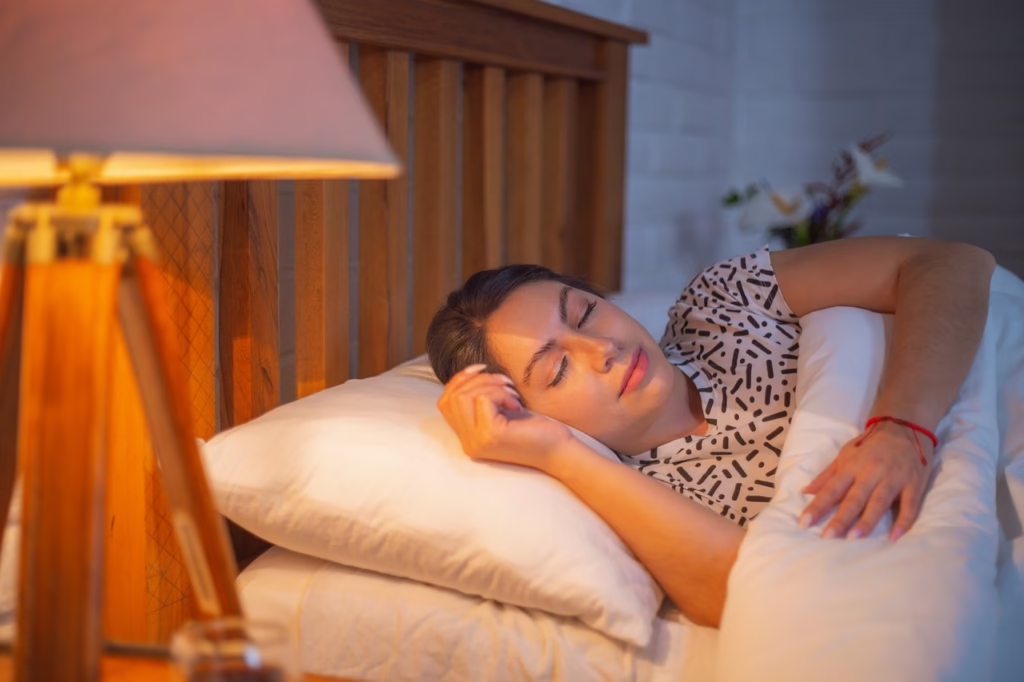What Is Sleep Sync?
To put it simply, sleep sync is the practice of aligning your sleep cycles with two powerful natural rhythms:
- Your circadian rhythm (the internal body clock that follows a 24-hour cycle)
- The Moon’s orbit (with its 29.5-day phases)
Interestingly, what ancient cultures followed through instinct is now backed by modern research.
In fact, 73% of people say they sleep more soundly when synced with the new moon.
Moreover, studies show that 24 hours after a full moon, people experience 22% more wakefulness during sleep.
Surprisingly, full moon nights display 22% more awakenings throughout the night.
Additionally, good sleep can reduce the risk of nighttime wakeups by 40%.
The Science Behind Sleep Sync
Circadian Rhythm: Sleep’s Internal Conductor
At the core of sleep sync lies your circadian biology.
To begin with, morning light exposure helps signal your internal body clock.
Meanwhile, melatonin release kicks in with the darkness of evening.
Altogether, this cycle functions best when your sleep and wake times stay consistent.
Moon Impact on Sleep Quality
Alongside circadian rhythms, lunar phases also play a key role in sleep patterns.
For instance, new moons are ideal for early and deeper sleep.
Over time, as the waxing moon phase progresses, people report noticeable energy increases.
Interestingly, the moon’s position is linked with more frequent night wakings—especially waking to urinate.
Additionally, the waxing moon is often linked to increased dream activity.
As the cycle reaches the full moon, it becomes a time associated with reward and emotional clarity.
By contrast, the waning moon encourages winding down and reflection.
“Inhabitants syncing their sleep to the moon phases fell asleep 15 minutes faster.” – Current Biology Journal
Optimizing Your Circadian Rhythm Schedule
Daily Sleep Alignment Routine
Start your morning (between 6–8 AM) with 10 minutes of natural sunlight exposure.
If needed, include a 20-minute power nap in the early afternoon (1–3 PM).
By evening, dim the lights and completely avoid screens as bedtime approaches.
Eventually, aim for full darkness at night to maximize melatonin production.
Moon Phase Adjustments
| Phase | Sleep Sync Tip | Benefit |
|---|---|---|
| New Moon | Early bedtime (by 9 PM) | Maximizes deep sleep |
| Waxing Moon | Increase activity | Balances growing energy |
| Full Moon | Use blackout curtains | Counters sleep disruption |
| Waning Moon | Practice extra meditation | Prepares body for emotional renewal |
Each lunar phase can help guide your sleep strategy more naturally.
Thus, adjusting your bedtime accordingly can create a strong foundation for better rest.
More Advanced Methods for Aligning Your Sleep
Tech That’ll Get You a Better Night of Sleep
Several tools can support your sleep syncing goals.
To start, the Oura Ring helps track how moon phases affect your sleep quality.
Additionally, a sunrise alarm can help you wake gently with light and sound that mimic nature.
Finally, blue light blockers are essential to preserve melatonin production in the evening.
Nutritional Sleep Sync
In terms of food, finish dinner at least three hours before going to bed.
Notably, sleep-friendly foods like cherries, almonds, and chamomile tea support melatonin levels.
Still, make sure to limit fluids at least two hours before bed to reduce nighttime bathroom visits.
Typical Sleep Position Problems
Shift Work
For shift workers, blackout curtains and red night lights are essential.
Additionally, keeping consistent sleep and wake times—even on days off—can stabilize the body clock.
As a temporary aid, melatonin supplements may also help reset the rhythm.
Jet Lag
When traveling across time zones, start adjusting meal times to the destination schedule in advance.
Furthermore, timed light exposure—either natural or via special glasses—helps your body adapt.
Generally, allow one day per time zone for full adjustment and recovery.
Success Stories
Case Study 1: Sarah, 34
Issue: Waking at 2 AM every night
Sleep Solution: Adjusted her bedtime based on the moon cycle
Outcome: Saw an 85% reduction in nighttime wake-ups
Case Study 2: Mark, 42 (Night Shift Worker)
Issue: Trouble sleeping during the day
Sleep Solution: Used red light therapy and maintained total darkness
Outcome: Achieved 6 hours of uninterrupted daytime sleep
Your 7-Day Sleep Sync Quick Start Guide
- Day 1–2: Begin observing your current sleep patterns
- Day 3–4: Incorporate a morning sunlight routine
- Day 5–6: Adjust to evening light exposure by dimming lights and avoiding screens
- Day 7: Go to bed based on the current moon phase
Gradually, these small changes add up to noticeable improvements.
Sleep Sync FAQs
Q: How long will it be before I notice a difference?
A: Many people report positive changes within just 3–5 nights of following sleep alignment routines.
Q: Does this help with insomnia?
A: Absolutely. Studies suggest up to 68% of chronic insomnia improves with consistent sleep timing.
Q: Is it okay to use sleep sync with young children?
A: Yes — children’s body clocks are highly responsive to circadian and moon-phase alignment.
Conclusion: Follow Your Body’s Natural Sleep-Wake Cycle
By aligning with your circadian rhythm and lunar phases, you’ll benefit in several key ways:
✔ Fall asleep faster
✔ Enter deeper, more restorative sleep
✔ Wake naturally without alarms
✔ Stay in tune with nature’s seasonal shifts
Tonight’s Sleep Sync Tip: Look up the moon phase in your region and adjust your bedtime accordingly.
In the end, your body will thank you.


1 Comment
Pingback: Natural Remedies for Insomnia: Sleep Better Tonight - WELLNESS ADDITION